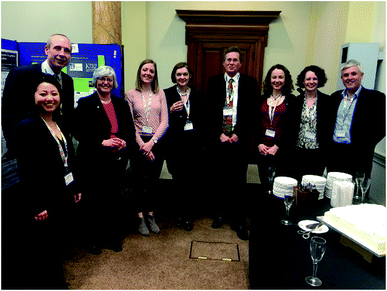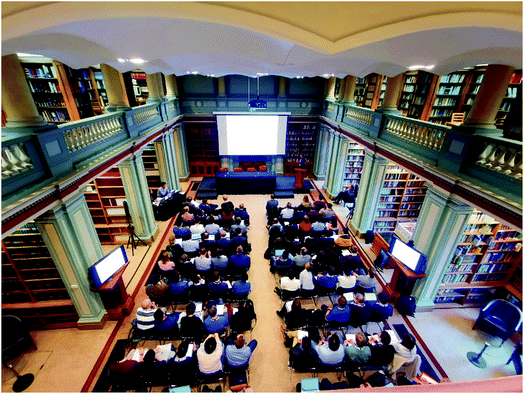The 300th Faraday Discussion
Susan
Weatherby
 *a,
John
Seddon
*a,
John
Seddon
 b and
Claire
Vallance
b and
Claire
Vallance
 c
c
aRoyal Society of Chemistry, Thomas Graham House, Science Park, Milton Road, Cambridge CB4 OWF, UK. E-mail: weatherbys@rsc.org
bChemistry Department, Molecular Sciences Research Hub, Imperial College London, Wood Lane, London W12 0BZ, UK
cDepartment of Chemistry, University of Oxford, Chemistry Research Laboratory, 12 Mansfield Rd, Oxford OX1 3TA, UK
In addition to the participants at the 300th meeting, a number of guests who have been instrumental to the organisation of the Discussions over the past ten years attended the 300th meeting celebrations on the first day. These included many past and current members of the Faraday Division Council and the Faraday Standing Committee on Conferences (Fig. 1). The celebrations commenced with an overview talk on the history and significance of the Discussions given by Claire Vallance, President of the Faraday Division Council, and John Seddon, Chair of the Faraday Standing Committee on Conferences (FSCC). The regular Discussion poster session and wine reception that followed was upgraded to a celebratory glass of bubbly and celebratory anniversary cake, which was enjoyed by all participants.
 | ||
| Fig. 1 Celebrating the 300th Discussion: Wendy Niu, Andy Mount, Eleanor Campbell, Philippa Ross, Sandra Macaskill, John Seddon, Claire Vallance, Susan Weatherby and Dwayne Heard. | ||
The Faraday Discussions have an interesting history, which began in 1902, when a group of British physical chemists decided to set up a new society. The Faraday Society was founded in 1903, with the aim of “promoting the study of electrochemistry, electrometallurgy, chemical physics, metallurgy, and kindred subjects”. There was some grumbling from famous scientists of the day at the prospect of a new society and the inevitable new journal, on the grounds that there were already too many journals to keep up with.
The Faraday Society originally held what were called Ordinary Meetings, at which a wide variety of scientific topics were discussed. Right from the start, the focus was on discussion, and all papers were circulated beforehand. In 1906, the Council proposed holding scientific meetings for which all papers presented were on a common theme. This marked the true start of the Faraday Discussions.
The first Faraday Discussion was held on 29th January 1907, on the topic of Osmotic Pressure, with Professor H. E. Armstrong FRS in the Chair. Indeed, this was the topic for which the very first Nobel Prize in Chemistry had been awarded, to Jacobus H. van’t Hoff, in 1901.
Since 1910 there has been at least one Discussion each year, even through two world wars. Nowadays there are approximately eight Discussions a year, on a wide variety of topics suggested by the scientific community. While the first meetings focused on topics that would have been of direct interest to Michael Faraday himself, over the years the scope of the meetings has broadened, and they now often cover topics at the interfaces of chemistry, biology, and physics.
The concerns of those who grumbled about the setting up of the Faraday Society turned out to be very well justified: alongside the meetings, the Faraday Society did indeed start its own journal. Transactions of the Faraday Society was established in 1905 to publish the Society’s Discussions. In 1947 this was split into two journals, Faraday Transactions, and the Faraday Discussions. The numbering of the current Faraday Discussions volume starts from 1947 with volume 1, hence this 300th meeting is numbered as the 214th volume.
A number of traditions have been introduced during the history of the Discussions. One is the Spiers Memorial Award, presented to an Introductory Lecturer in recognition of their outstanding contribution to the field of the Discussion. The award commemorates F. S. Spiers, the first secretary of the Faraday Society. One of the 2019 joint winners of this award, Naomi Halas, was present at the 300th Discussion. Another tradition is the Loving Cup ceremony, the Loving cup was purchased by the Faraday Society in 1950, to commemorate G. S. W. Marlow, Secretary of the Faraday Society 1926–1948. The cup is used at Faraday Discussion conference dinners, where a toast to the memory of Marlow is given, and to the memory of Angela and Tony Fish. Angela Fish worked for the Royal Society of Chemistry from 1968–1995 and was most closely associated with the organisation of the Faraday Discussion meetings. She left a legacy to the Royal Society of Chemistry in both her name and that of her husband Tony. The 300th meeting was no exception to this unique tradition, and all delegates enjoyed the Loving Cup ceremony, if not necessarily all partaking of the port therein.
From a Discussion in 1935 that is recognised as the birth of polymer physics, to a Discussion on atmospheric chemistry in 1995 taking place just when the discipline was expanding, Faraday Discussions have always been at the cutting edge of chemistry, attended by world-leading scientists, and have paved the way for significant scientific advances. The discussion-driven format of the meetings is a unique feature. Many attendees have commented on the fact that the longer discussion time really allows for open debates, where young researchers can interact with world-leading scientists in their field. The 300th meeting had its fair share of robust and insightful discussion, as you will find later in this volume and as shown in Fig. 2.
Since their inception, more than 40![[thin space (1/6-em)]](https://www.rsc.org/images/entities/char_2009.gif) 000 delegates have attended Faraday Discussions. During the last decade, the Royal Society of Chemistry has increasingly organised Discussion meetings outside the UK, in countries where there is substantial high-quality research. In recent years, Discussions have been held in China, India, and South Africa, and we expect this trend to continue.
000 delegates have attended Faraday Discussions. During the last decade, the Royal Society of Chemistry has increasingly organised Discussion meetings outside the UK, in countries where there is substantial high-quality research. In recent years, Discussions have been held in China, India, and South Africa, and we expect this trend to continue.
Of course, the Discussions would not be possible without the many volunteers and Royal Society of Chemistry staff members who contribute to their organisation. On the occasion of this 300th meeting, we would like to formally thank all those who have made the Discussions what they are today. To all the past members of the FSCC, the members of each Discussion scientific committee, the authors/speakers and the participants themselves – thank you. To all the Royal Society of Chemistry staff – thank you. Around 50 staff each year are currently involved in some aspect of their organisation and many more across the years. All play a role in making Faraday Discussions the unique and world-leading series that they are.
A list of upcoming Discussions can be found on the Royal Society of Chemistry website (http://rsc.li/faraday-discussion). Over the coming two years, topics such as quantum effects in complex systems, peptide–membrane interactions, and the chemistry of 2D materials will be covered. The FSCC is always looking for new proposals in exciting and rapidly developing areas of physical sciences. More information and contact details are available on the Royal Society of Chemistry website (http://www.rsc.org/faraday_d).
Susan Weatherby, Programme Manager, Royal Society of Chemistry
Claire Vallance, President of Faraday Division and University of Oxford
John M. Seddon, Chair, Faraday Standing Committee on Conferences and Imperial College London
| This journal is © The Royal Society of Chemistry 2019 |

